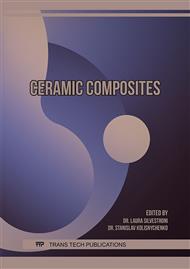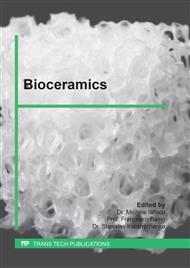p.206
p.212
p.218
p.223
p.229
p.235
p.242
p.248
p.254
Influence of Thermal Treatment Temperature on Phase Formation and Bioactivity of Glass-Ceramics Based on the SiO2-Na2O-CaO-P2O5 System
Abstract:
In this work, the thermal treatment temperature effect on phase formation and bioactivity of glass-ceramics based on the SiO2-Na2O-CaO-P2O5 system has been studied. The chemical composition of the system is 45 wt.% SiO2, 24.5 wt.% Na2O, 24.5 wt.% CaO and 6 wt.% P2O5 (45S5). The rice husk ash is used as the natural raw materials instead of commercial SiO2. All of the investigated compositions were prepared by melting the glass mixtures at 1350°C for 3 h. The resulting glass samples were heated at different thermal treatment temperatures ranging from 750 to 1050°C with fixed dwell-time for 4 h for crystallization. Phase identification of the 45S5 glass ceramics was carried out by X-Ray diffraction (XRD). Moreover, the physical properties such as density, porosity and mechanical properties were systematically investigated. It was found that, the increasing of heat treatment temperature led to the increasing of the Na2Ca2Si3O9 phase and obtaining better bioactive behavior after incubation of glass-ceramics in simulated body fluid (SBF) for 7 days. The maximum hardness value of 4.02 GPa was achieved after heating at 1050°C for 4 h. However, the density value has slightly changed with various heat treatment temperatures.
Info:
Periodical:
Pages:
229-234
Citation:
Online since:
April 2019
Keywords:
Price:
Сopyright:
© 2019 Trans Tech Publications Ltd. All Rights Reserved
Share:
Citation:




